新闻英语语言特征
浅谈新闻英语的语言特点

浅谈新闻英语的语言特点新闻英语可谓是现代英语中最为流行和广泛应用的语言形式之一,因为全球的新闻都要使用英语进行报道和传播。
新闻英语具有其独特的语言特点,本文将通过语法、词汇、语气等方面探讨这些特点。
语法特点1.时态和语态的使用新闻英语常使用现在完成时和被动语态,因为这种语态能够突出所报道的事件和消息的重要性。
例如:The plane has crashed.(飞机已经坠毁了。
)2.直语和简短的句子新闻英语追求简短准确,因此喜欢使用直语和简单的句子。
另外,新闻英语常常使用主语+动词+宾语的结构,以突出新闻的主要信息。
例如:The president signed the bill.(总统签署了这个法案。
)3.名词性从句的使用新闻英语中经常使用名词性从句,尤其是用作同位语说明某人或某事物的身份。
例如:The reporter, who came from CNN, asked the president a question.(来自CNN的记者问了这位总统一个问题。
)词汇特点1.外来词的使用新闻英语中使用大量的外来词,尤其是拉丁语和希腊语的词汇,因为这些词汇在许多学科和专业领域中被广泛使用。
例如:The president gave a speech about the importance of the economy.(总统发表了一篇关于经济重要性的演讲。
)2.常用简洁词的使用新闻英语喜欢使用一些常用简洁的词汇,以便让新闻更加容易理解。
例如:The police arrested the suspect.(警察逮捕了嫌疑犯。
)3.用词准确新闻英语中所使用的单词、短语都应该非常准确,因为一些偏差或错误的词汇使用可能会给报道带来歧义或误解。
例如:The protesters demonstrated outside the courthouse.(抗议者在法院外面举行了示威活动。
)语气特点1.中立、客观新闻英语的特点之一就是追求中立和客观,因此使用的语气也应该尽量避免过于主观或情绪化的表达。
新闻英语的语言特点

c l p e 实 际 上是 动词 转 来 的名 词 。B句 ol s a
戏 院 倒 塌 死 伤 一 个 ) 或 ,Yetra ,a sed y
t e tr whc c l p e i Wa hn t n h ae , ih o l s d n a s i go ,
外 英 语 新 闻标 题 中广 泛 使 用 名 词 和 简 短
小 词 mig t od) 报 纸 标 题 尤 能 反 映 新 d e w rs, 闻英 语 的 这 一 特 点 , 因为 名 词 具 有 很 强 的
惊讶)
C . r o 1 R a d Afe Thra Gil f 8 pe tr et
e y a ma i ra i ( 8 岁 女 n b n W t B e d Knf 1 h e
孩 受 到 面 包 刀 威 胁 后 遭 强 暴 ) 句 = a : D Vn
宾 语 部 分,引 起读 者注 意 。对英 语 新 闻标
W i ed Knf. 1 t Bra i ( 8岁女 孩 受 到 面 包刀 h e
威 胁后 遭 强暴 )
D . n Gog Va h’ S e o rd Afe e . r c ve e t ̄h f
f ・ 的 画 失而 复 得) 凡 高 在 这 4个 标 题 中 . 闻 英语 显 示 了 以 新 当今 全 球 科 技 日新 月 异 . 播 媒 体 蓬 传 下 4个 方 面 的个 性 : 词 性 的使 用 : 句 中 有 两 个 名 词 . A 即
新 闻 英 语 的 语 言 特 点
新 闻 英 语 具 备 了一 般 新 闻所 具 有 的 特 点 , 是 它 也 有 其 独 特 的 个 性 , 用 少 但 即
新闻英语语篇修辞研究

新闻英语语篇修辞研究一、引言新闻英语是英语语言的一个重要分支,广泛应用于全球范围内的新闻报道和信息传播。
在新闻英语语篇中,修辞手法作为一种重要的表达手段,对于传递信息、表达观点和构建语境具有重要的作用。
本文将对新闻英语语篇中的修辞手法进行深入探讨,以期为新闻从业人员和语言研究者提供有益的参考。
二、新闻英语语篇特征新闻英语语篇具有以下特征:简练、准确、客观、具体和生动。
这些特征使得新闻英语能够快速、准确地传递信息,同时吸引读者的注意力。
三、修辞手法分类在新闻英语中,常用的修辞手法包括隐喻与象征、对比与反衬、排比与反复、借代与提喻、委婉与含蓄等。
这些修辞手法在新闻报道中发挥着重要的作用,能够增强语言的表达力,使新闻更加生动有趣。
四、隐喻与象征隐喻和象征是新闻英语中常用的修辞手法之一。
隐喻是一种通过比喻来表达意义的修辞方式,而象征则是通过具体事物或形象来表达某种抽象概念或意义的修辞方式。
例如,在新闻报道中使用“黑金”来隐喻石油行业的腐败问题,使用“钢铁长城”来象征中国的强大防御力量。
五、对比与反衬对比和反衬是通过比较两种事物或概念来强调其差异性或相似性的修辞方式。
在新闻英语中,这种修辞手法可以突出事物的特点,加深读者对新闻的理解。
例如,在报道中美贸易战时,可以使用对比手法来强调两国在经济领域的不同之处。
六、排比与反复排比和反复是新闻英语中常用的修辞手法之一。
排比是通过连续使用三个或以上结构相似的句式来表达某种情感或观点的修辞方式;反复则是通过重复某个词语或句子来强调某种情感或观点的修辞方式。
例如,在报道国际会议时,可以使用排比手法来列举各国领导人的发言;在报道某项政策时,可以使用反复手法来强调该政策的重要性。
七、借代与提喻借代和提喻是新闻英语中较为特殊的修辞手法之一。
借代是通过借用某个事物的特征来代替另一个事物的修辞方式;提喻则是通过以部分代替整体或以整体代替部分的修辞方式。
例如,在报道某个国家的经济情况时,可以使用借代手法来形容该国经济的“发动机”;在报道某城市的人口情况时,可以使用提喻手法来说明该城市人口的“膨胀”。
新闻英语的特点及翻译技巧

新闻英语的特点及翻译技巧1. 引言1.1 新闻英语的重要性Currently, I need to produce an article about the characteristics and translation techniques of news English based on my outline. The outline includes an Introduction: [Importance of News English, Characteristics of News English], Body: [Conciseness of News English, Objectivity of News English, Accuracy of News English, Translation Techniques of News English, Learning Methods of News English], Conclusion: [Summary of the Characteristics and Translation Techniques of News English]. Now, please provide the content related to the Importance of News English in the Introduction section with a word count requirement of 200 words. Just focus on the content, and do not include any information unrelated to the content.1.2 新闻英语的特点新闻英语的特点在于其简练、客观和准确。
新闻英语通常采用简洁明了的语言,避免冗长复杂的句子,以便读者能够迅速理解新闻内容。
英语新闻标题的语言特点
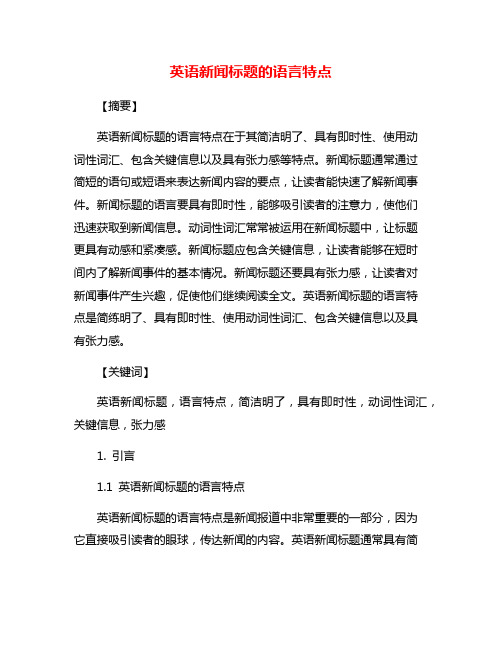
英语新闻标题的语言特点【摘要】英语新闻标题的语言特点在于其简洁明了、具有即时性、使用动词性词汇、包含关键信息以及具有张力感等特点。
新闻标题通常通过简短的语句或短语来表达新闻内容的要点,让读者能快速了解新闻事件。
新闻标题的语言要具有即时性,能够吸引读者的注意力,使他们迅速获取到新闻信息。
动词性词汇常常被运用在新闻标题中,让标题更具有动感和紧凑感。
新闻标题应包含关键信息,让读者能够在短时间内了解新闻事件的基本情况。
新闻标题还要具有张力感,让读者对新闻事件产生兴趣,促使他们继续阅读全文。
英语新闻标题的语言特点是简练明了、具有即时性、使用动词性词汇、包含关键信息以及具有张力感。
【关键词】英语新闻标题,语言特点,简洁明了,具有即时性,动词性词汇,关键信息,张力感1. 引言1.1 英语新闻标题的语言特点英语新闻标题的语言特点是新闻报道中非常重要的一部分,因为它直接吸引读者的眼球,传达新闻的内容。
英语新闻标题通常具有简洁明了、具有即时性、使用动词性词汇、包含关键信息和具有张力感等特点。
英语新闻标题通常非常简洁明了。
标题要尽可能用简洁的语言表达出新闻的主要内容,吸引读者注意。
过长的标题会让读者失去兴趣,所以标题要简短有力。
英语新闻标题具有即时性。
标题通常会反映新闻事件的最新进展,让读者能够第一时间获取到最新的信息。
即时性是新闻报道的基本要求,所以标题需要及时准确地传达新闻内容。
英语新闻标题通常使用动词性词汇。
动词能够让标题更有活力和张力,吸引读者的注意。
动词性词汇能够让标题更加生动、鲜活,增加新闻内容的吸引力。
英语新闻标题包含关键信息。
标题要能够准确地表达新闻事件的主要内容,让读者一目了然。
关键信息的呈现能够让读者迅速了解新闻的要点,提高阅读效率。
英语新闻标题通常具有张力感。
标题要能够引起读者的兴趣和好奇心,激发他们阅读新闻内容的欲望。
张力感能够让标题更具吸引力,让读者愿意点击进入阅读更多内容。
2. 正文2.1 简洁明了Newspaper headlines are known for their concise and clear language, delivering important information in a brief and impactful way. The essence of a headline lies in its ability to capture the reader's attention quickly and effectively, making it a crucial element of news reporting.2.2 具有即时性英语新闻标题的语言特点之一是具有即时性。
英语新闻语言特点
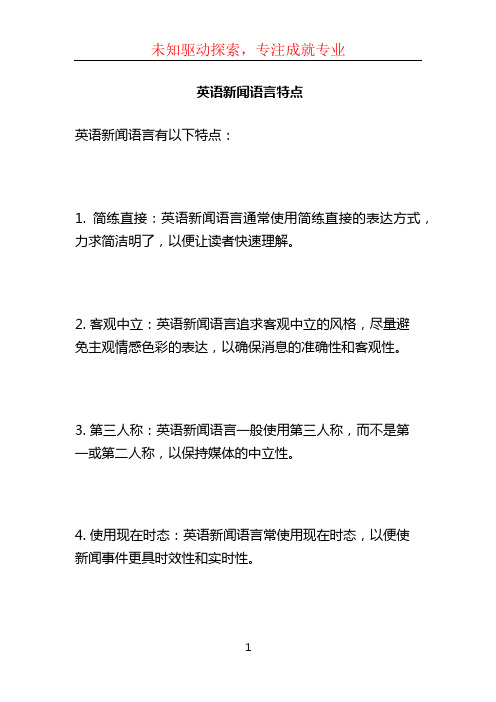
英语新闻语言特点
英语新闻语言有以下特点:
1. 简练直接:英语新闻语言通常使用简练直接的表达方式,力求简洁明了,以便让读者快速理解。
2. 客观中立:英语新闻语言追求客观中立的风格,尽量避
免主观情感色彩的表达,以确保消息的准确性和客观性。
3. 第三人称:英语新闻语言一般使用第三人称,而不是第
一或第二人称,以保持媒体的中立性。
4. 使用现在时态:英语新闻语言常使用现在时态,以便使
新闻事件更具时效性和实时性。
5. 使用客观事实和数据:英语新闻语言通常会提供客观的事实和数据支持,以增加新闻报道的可信度和权威性。
6. 使用专业术语和惯用语:英语新闻语言常使用专业术语和惯用语,以便传达特定行业或领域的信息,同时也要注意避免使用过于复杂的术语,以保证读者的理解。
7. 限定句式和词汇选择:英语新闻语言通常使用简单明了的句式和常见的词汇选择,以便使新闻更易于理解,同时也要注重语言的精确性和准确性。
总的来说,英语新闻语言追求简洁明了、客观中立和准确权威的特点,以便让读者快速理解、获取信息。
新闻英语翻译特点与技巧分析

新闻英语翻译特点与技巧分析新闻英语翻译是一种特殊的领域,具有一些独特的特点和技巧。
以下是对新闻英语翻译的特点和技巧的分析。
特点:1. 精确性:新闻英语翻译要求准确传达信息,包括事实、数据和观点等。
翻译人员需要注意细节,确保新闻的内容和意义在翻译中被准确地传达出来。
2. 实时性:新闻是时效性很强的,翻译人员需要迅速完成翻译工作,以便新闻能够及时发布。
他们需要有紧迫感和快速反应能力,以应对紧急情况,如突发事件或重大新闻。
3. 风格:新闻英语具有简洁、明了的特点,翻译人员需要尊重新闻的语言风格,并尽可能保留原文的简洁性和清晰度。
他们需要运用恰当的词汇和表达方式,以确保翻译的新闻具有与原文相同的效果。
技巧:1. 快速反应:新闻英语翻译需要迅速反应,翻译人员应该在第一时间阅读和理解原文,并开始翻译工作。
他们需要高度集中和专注,以保持快速的工作效率。
2. 处理固定表达:新闻中常常出现一些固定的表达方式,如惯用语和俗语等。
翻译人员需要熟悉这些表达,并找到相应的对等或类似表达。
他们可以使用参考资料,如词典或类似的新闻报道,来帮助他们进行翻译。
3. 根据上下文理解:在某些情况下,新闻报道可能会出现一些语义不明确或含糊的词汇或句子。
翻译人员需要根据上下文进行理解和推断,并选择最合适的翻译。
他们需要注意上下文的语境和逻辑关系,以确保翻译的准确性和连贯性。
4. 词汇选择:新闻英语翻译需要准确选择合适的词汇,以便传达原文的含义和情感。
翻译人员需要熟悉相关领域的词汇,并了解其在新闻报道中的用法。
他们可以参考类似的新闻报道和新闻机构的用语规范,以确保词汇的准确性和一致性。
5. 格式和结构:新闻英语翻译需要保持原稿的格式和结构。
翻译人员应该注意段落、标题和标点等的正确使用,并尽量保持原文的篇幅和布局。
他们还应该注意语言的流畅性和连贯性,以便读者能够准确理解翻译的内容。
总结:新闻英语翻译具有精确性和实时性的特点,翻译人员需要保持快速反应和准确传达信息的能力。
浅谈新闻英语的语言特点

( 一) 名词 + 现在分词构成前置定语。如: law - abiding citizens。 ( 二) 名词 + 形容词构成前置定语。如: time - conscious Americans ( 三) 名词 + 名词构成前置定语。如: Qinghai Tibet railway。 ( 四) 名词 + 过去分词构成前置定语。如: state - owned enterprises。 ( 五) 形容词 + 过去分词构成前置定语。如: well - informed sources。 ( 六) 副词 + 过去分词构成前置定语。如: highly - placed sources。 ( 七) 形容词 + 名词构成前置定语。如: long - term goal。 ( 八) 数词 + 名词构成前置定语。如: two - sidetalk。 ( 九) 其他合成词组构成前置定语。如: stand - still - and - lose policy。
省略的使用
在新闻英语的标题中,经常在语法和句法层面 上进行省 略,目的是节省篇幅,突出重点。通常在 不影响理解新闻 主题大意的前提下,故意省略某些 带有语法成分的虚词, 主要有冠词、助动词“be”、系动词、连词、代词。 例如China to issue medical information card.( China Daily , Feb , 3 , 2012) 和 Chinese fishing boat captain repatriated.( China Daily,Feb,3,2012)。在第一个例 子中,“ to ”前面省略了助动词“is ”; 在第二个例子中, “repatriated ”前面省略了表示被动语态的助动词“was”。
新闻英语的语言特点
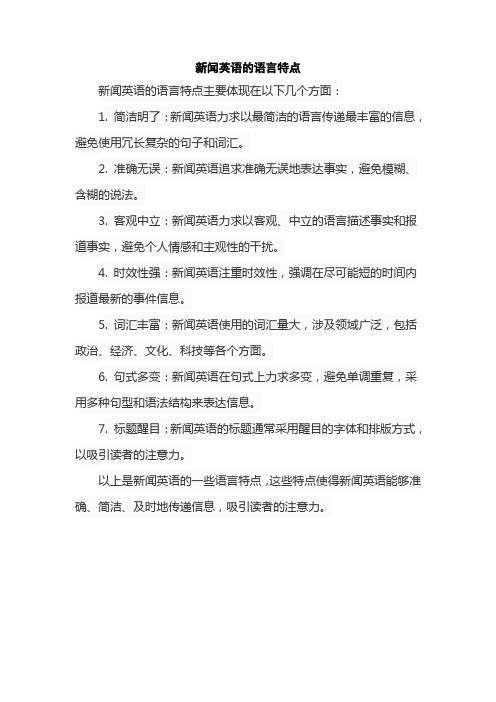
新闻英语的语言特点
新闻英语的语言特点主要体现在以下几个方面:
1. 简洁明了:新闻英语力求以最简洁的语言传递最丰富的信息,避免使用冗长复杂的句子和词汇。
2. 准确无误:新闻英语追求准确无误地表达事实,避免模糊、含糊的说法。
3. 客观中立:新闻英语力求以客观、中立的语言描述事实和报道事实,避免个人情感和主观性的干扰。
4. 时效性强:新闻英语注重时效性,强调在尽可能短的时间内报道最新的事件信息。
5. 词汇丰富:新闻英语使用的词汇量大,涉及领域广泛,包括政治、经济、文化、科技等各个方面。
6. 句式多变:新闻英语在句式上力求多变,避免单调重复,采用多种句型和语法结构来表达信息。
7. 标题醒目:新闻英语的标题通常采用醒目的字体和排版方式,以吸引读者的注意力。
以上是新闻英语的一些语言特点,这些特点使得新闻英语能够准确、简洁、及时地传递信息,吸引读者的注意力。
新闻英语的特点及翻译技巧
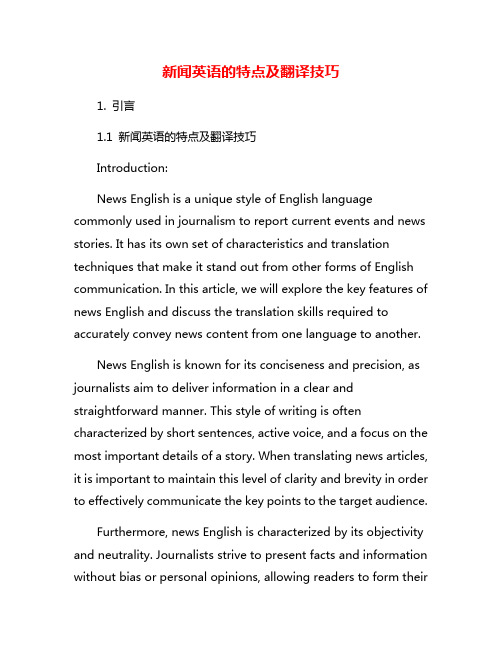
新闻英语的特点及翻译技巧1. 引言1.1 新闻英语的特点及翻译技巧Introduction:News English is a unique style of English language commonly used in journalism to report current events and news stories. It has its own set of characteristics and translation techniques that make it stand out from other forms of English communication. In this article, we will explore the key features of news English and discuss the translation skills required to accurately convey news content from one language to another.News English is known for its conciseness and precision, as journalists aim to deliver information in a clear and straightforward manner. This style of writing is often characterized by short sentences, active voice, and a focus on the most important details of a story. When translating news articles, it is important to maintain this level of clarity and brevity in order to effectively communicate the key points to the target audience.Furthermore, news English is characterized by its objectivity and neutrality. Journalists strive to present facts and information without bias or personal opinions, allowing readers to form theirown conclusions. Translators must also maintain this impartiality when translating news articles, ensuring that the original meaning is accurately conveyed without adding any personal interpretation.In addition, news English is known for its timeliness and immediacy. News stories are often published quickly to keep up with the rapid pace of current events. Translators must work efficiently to produce accurate translations in a timely manner, ensuring that the news remains relevant and up-to-date for readers in different languages.Overall, the characteristics of news English, including its conciseness, objectivity, timeliness, and precision, present unique challenges for translators. By understanding and applying the appropriate translation techniques, translators can effectively convey the essence of news articles while maintaining the integrity of the original content. In the following sections, we will delve deeper into these specific features of news English and explore the translation skills required to successfully transfer this style of writing into different languages.2. 正文2.1 新闻英语的语言简洁精准新闻英语的语言简洁精准,是其独特的特点之一。
新闻英语语言特点英语
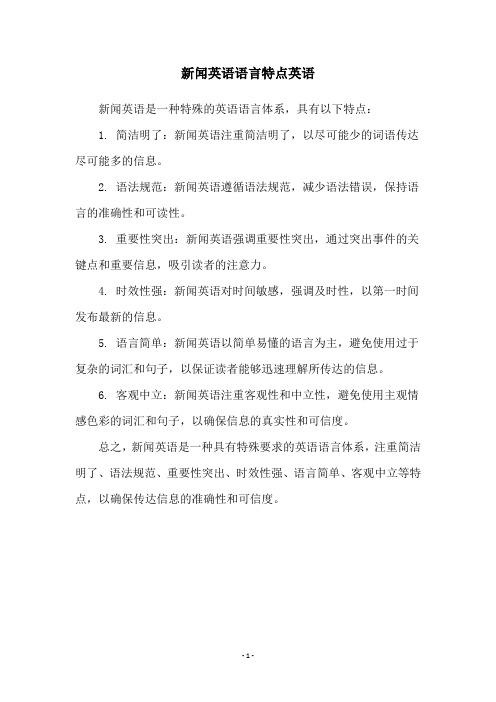
新闻英语语言特点英语
新闻英语是一种特殊的英语语言体系,具有以下特点:
1. 简洁明了:新闻英语注重简洁明了,以尽可能少的词语传达尽可能多的信息。
2. 语法规范:新闻英语遵循语法规范,减少语法错误,保持语言的准确性和可读性。
3. 重要性突出:新闻英语强调重要性突出,通过突出事件的关键点和重要信息,吸引读者的注意力。
4. 时效性强:新闻英语对时间敏感,强调及时性,以第一时间发布最新的信息。
5. 语言简单:新闻英语以简单易懂的语言为主,避免使用过于复杂的词汇和句子,以保证读者能够迅速理解所传达的信息。
6. 客观中立:新闻英语注重客观性和中立性,避免使用主观情感色彩的词汇和句子,以确保信息的真实性和可信度。
总之,新闻英语是一种具有特殊要求的英语语言体系,注重简洁明了、语法规范、重要性突出、时效性强、语言简单、客观中立等特点,以确保传达信息的准确性和可信度。
- 1 -。
新闻英语翻译特点与技巧分析
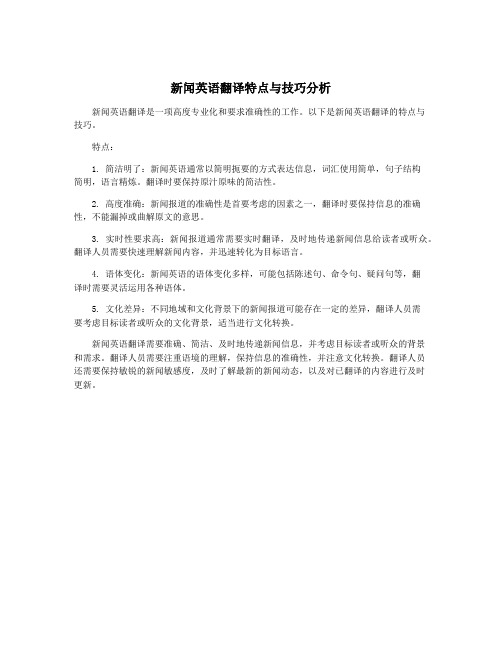
新闻英语翻译特点与技巧分析
新闻英语翻译是一项高度专业化和要求准确性的工作。
以下是新闻英语翻译的特点与
技巧。
特点:
1. 简洁明了:新闻英语通常以简明扼要的方式表达信息,词汇使用简单,句子结构
简明,语言精炼。
翻译时要保持原汁原味的简洁性。
2. 高度准确:新闻报道的准确性是首要考虑的因素之一,翻译时要保持信息的准确性,不能漏掉或曲解原文的意思。
3. 实时性要求高:新闻报道通常需要实时翻译,及时地传递新闻信息给读者或听众。
翻译人员需要快速理解新闻内容,并迅速转化为目标语言。
4. 语体变化:新闻英语的语体变化多样,可能包括陈述句、命令句、疑问句等,翻
译时需要灵活运用各种语体。
5. 文化差异:不同地域和文化背景下的新闻报道可能存在一定的差异,翻译人员需
要考虑目标读者或听众的文化背景,适当进行文化转换。
新闻英语翻译需要准确、简洁、及时地传递新闻信息,并考虑目标读者或听众的背景
和需求。
翻译人员需要注重语境的理解,保持信息的准确性,并注意文化转换。
翻译人员
还需要保持敏锐的新闻敏感度,及时了解最新的新闻动态,以及对已翻译的内容进行及时
更新。
新闻英语翻译特点与技巧分析

新闻英语翻译特点与技巧分析随着全球化的发展,英语已经成为了国际交流和信息传播的重要语言之一。
作为新闻传播的重要手段之一,新闻英语翻译在跨国传播和理解上扮演着重要的角色。
新闻英语翻译又有其特殊性,需要翻译人员具备一定的技巧和能力。
本文将就新闻英语翻译的特点与技巧进行分析。
一、新闻英语翻译的特点1. 时效性强:新闻报道的内容通常是与时事相关的,需要及时发布和传播,因此在翻译新闻时,必须保证翻译的及时性,不能拖延时间。
2. 信息量大:新闻报道通常包含大量信息,需要翻译人员将丰富的信息用简练准确的语言表达出来,以保证读者对新闻内容的深入理解。
3. 语言规范:新闻英语有其特殊的语言规范,如简练明了、逻辑严密、客观公正等,翻译人员需要将这些规范体现在翻译中。
4. 文体多样:新闻报道的文体多种多样,有新闻报道、评论、专栏等,翻译人员需要根据不同的文体要求采用不同的翻译技巧。
5. 综合能力要求高:翻译新闻需要涉及到政治、经济、社会、文化等多个领域,翻译人员需要具备丰富的知识储备和广泛的视野。
针对新闻英语翻译的特点,翻译人员需要掌握一些翻译技巧,以保证翻译质量和效率。
1. 精准把握信息:翻译人员要准确把握新闻报道的主旨和重点信息,对于一些涉及政治、经济等重要领域的报道,要特别注意信息的准确性和客观性。
2. 把握语言特点:新闻英语有其独特的语言特点,如标题简洁明了、报道叙述清晰、评论客观客观,翻译人员需要根据这些特点进行翻译,保持原文的风格和语气。
3. 处理时效性:新闻报道需要及时发布,对于一些重大事件的报道,要尽快完成翻译以保证信息的及时传播,因此翻译人员需要具备较强的应变能力和工作效率。
新闻英语翻译涉及到时效性、信息量大、语言规范和文体多样等多个特点,翻译人员需要具备较强的综合能力和翻译技巧。
只有不断提升自己的专业素养和能力,才能在新闻英语翻译领域取得更好的业绩。
希望通过本文的分析,能够对广大新闻英语翻译人员有所帮助。
新闻英语的特点及翻译技巧

新闻英语的特点及翻译技巧【摘要】是一个涉及语言特点和翻译技巧的话题。
新闻英语在传达信息时追求简明扼要、客观中立的风格,其中包含着大量的专业术语和简洁的句式结构。
在新闻翻译时,需要特别注意保持原文的语言风格和信息准确度,避免引入个人主观色彩。
新闻翻译中常见的困难包括时间压力和词汇选择的差异,需要在处理时加以注意。
为了提高新闻翻译的质量,译者可以采用一些技巧,如理解整个语境、保持风格一致等。
新闻英语的特点在于简洁明了、客观中立,而翻译技巧则需要保持信达雅,尽可能地传达原文意思。
展望未来,新闻英语翻译可能会更加强调多元化、快速性和精准度,适应信息时代的发展趋势。
【关键词】新闻英语、特点、翻译技巧、语言风格、注意事项、困难、技巧、总结、发展前景1. 引言1.1 新闻英语的特点及翻译技巧News English is a specialized form of language that is used in reporting current events. It has its own unique characteristics and translation techniques that make it distinct from other forms of English. In this article, we will explore the key features of newsEnglish and offer some tips for translating news articles accurately.2. 正文2.1 新闻英语的基本特点3. Conciseness: News English values economy of language, seeking to convey information in as few words as possible without sacrificing clarity or accuracy. It avoids unnecessary repetition or digression, getting to the heart of the matter efficiently.2.2 新闻英语的语言风格新闻英语的语言风格在许多方面都与普通英语有所不同,主要体现在以下几个方面:1. 简洁明了:新闻英语注重简洁明了的表达,避免冗长复杂的句子和词汇。
新闻英语的特点及翻译技巧

新闻英语的特点及翻译技巧【摘要】新闻英语是一种具有独特特点的语体,包括简洁性、客观性、紧凑性和措辞准确性。
简洁性体现在句子结构简单明了,让读者迅速获取信息;客观性要求报道客观中立,避免主观色彩;紧凑性要求信息量大,文章内容精炼;措辞准确性要求用词准确,避免歧义或误解。
在翻译新闻英语时,应保持原文的风格和特点,注重保持信息量和语言简练。
翻译技巧包括准确理解背景信息、保持语言流畅性和避免直译。
新闻英语的特点和翻译技巧相辅相成,旨在传达信息快速准确。
【关键词】新闻英语、特点、翻译技巧、简洁性、客观性、紧凑性、措辞准确性、引言、正文、结论1. 引言1.1 新闻英语的特点及翻译技巧Introduction:News English is a specialized form of English that is used in reporting news events. It is characterized by its clarity, objectivity, conciseness, and accuracy. Translating news English requires a careful understanding of these characteristics in order to accurately convey the meaning and tone of the original text. Inthis article, we will explore the key features of news English and provide some tips for translating it effectively.2. 正文2.1 新闻英语的简洁性新闻英语的简洁性是其一个重要的特点,它要求信息传达的速度和效率,避免冗长和繁杂的表达。
新闻英语通常采用简短、简洁的句子和词语,以最快地传达信息给读者。
新闻英语的特点
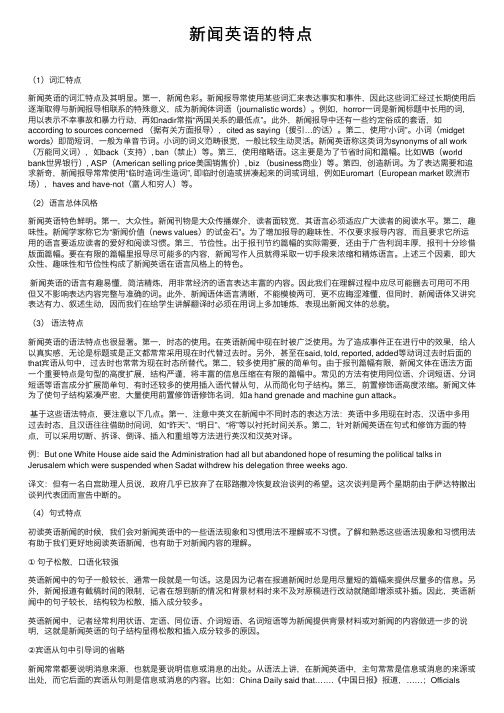
新闻英语的特点(1)词汇特点新闻英语的词汇特点及其明显。
第⼀,新闻⾊彩。
新闻报导常使⽤某些词汇来表达事实和事件,因此这些词汇经过长期使⽤后逐渐取得与新闻报导相联系的特殊意义,成为新闻体词语(journalistic words)。
例如,horror⼀词是新闻标题中长⽤的词,⽤以表⽰不幸事故和暴⼒⾏动,再如nadir常指“两国关系的最低点”。
此外,新闻报导中还有⼀些约定俗成的套语,如according to sources concerned (据有关⽅⾯报导),cited as saying(援引…的话)。
第⼆,使⽤“⼩词”。
⼩词(midget words)即简短词,⼀般为单⾳节词。
⼩词的词义范畴很宽,⼀般⽐较⽣动灵活。
新闻英语称这类词为synonyms of all work (万能同义词),如back(⽀持), ban(禁⽌)等。
第三,使⽤缩略语。
这主要是为了节省时间和篇幅。
⽐如WB(world bank世界银⾏), ASP(American selling price美国销售价), biz (business商业)等。
第四,创造新词。
为了表达需要和追求新奇,新闻报导常常使⽤“临时造词/⽣造词”, 即临时创造或拼凑起来的词或词组,例如Euromart(European market 欧洲市场),haves and have-not(富⼈和穷⼈)等。
(2)语⾔总体风格新闻英语特⾊鲜明。
第⼀,⼤众性。
新闻刊物是⼤众传播媒介,读者⾯较宽,其语⾔必须适应⼴⼤读者的阅读⽔平。
第⼆,趣味性。
新闻学家称它为“新闻价值(news values)的试⾦⽯”。
为了增加报导的趣味性,不仅要求报导内容,⽽且要求它所运⽤的语⾔要适应读者的爱好和阅读习惯。
第三,节俭性。
出于报刊节约篇幅的实际需要,还由于⼴告利润丰厚,报刊⼗分珍惜版⾯篇幅。
要在有限的篇幅⾥报导尽可能多的内容,新闻写作⼈员就得采取⼀切⼿段来浓缩和精炼语⾔。
新闻英语的特点及翻译技巧

新闻英语的特点及翻译技巧
新闻英语是一种特殊的语言形式,它具有一些独特的特点和翻译技巧。
在新闻报道中,准确、清晰、简洁是最基本的要求。
下面我们将就新闻英语的特点及翻译技巧进行详细的介绍。
一、新闻英语的特点
1. 简练明了:新闻报道要求用简练的语言、精炼的文字来表达观点和事实,避免冗
长及复杂的句子结构。
2. 客观公正:新闻英语要求客观报道事实,避免使用主观性词语和情感色彩的修饰,以保持客观公正的立场。
3. 快速传达信息:新闻报道要求在第一时间内迅速传达重要信息,因此语言要力求
简洁、直接,易于读者理解。
4. 角度鲜明:新闻报道往往会突出某一特定观点或角度,以引起读者的兴趣和关
注。
二、新闻英语的翻译技巧
1. 抓住新闻重点:在翻译新闻报道时,首先要抓住新闻的重点,尽量保持原文的简
洁明了,不妨碍读者对新闻的理解。
2. 翻译精准:新闻英语的翻译要求非常精准,不能加入自己的主观色彩,要准确表
达原文所传达的信息。
3. 保持客观中立:在翻译新闻报道时,要保持客观中立的态度,避免加入个人情感
和偏见。
4. 考虑读者群体:在翻译新闻报道时,要考虑到目标读者的文化背景和语言习惯,
选择适合读者理解的词语和句式。
5. 保持原文味道:在翻译新闻报道时,要尽量保持原文的味道和风格,避免过分“本土化”,以保证原文的信息传达。
通过以上介绍,相信大家对新闻英语的特点及翻译技巧有了更深入的了解。
在实际工作中,我们需要根据不同的新闻类型和情境来灵活运用这些特点和技巧,以确保新闻报道的准确传达和有效阅读。
新闻英语的特点及翻译技巧
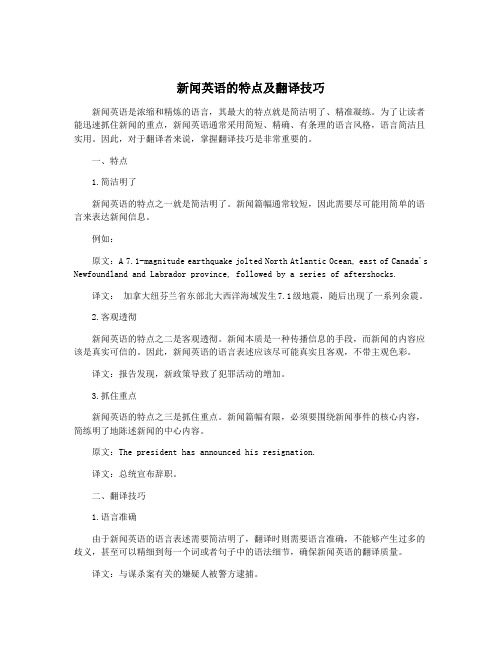
新闻英语的特点及翻译技巧新闻英语是浓缩和精炼的语言,其最大的特点就是简洁明了、精准凝练。
为了让读者能迅速抓住新闻的重点,新闻英语通常采用简短、精确、有条理的语言风格,语言简洁且实用。
因此,对于翻译者来说,掌握翻译技巧是非常重要的。
一、特点1.简洁明了新闻英语的特点之一就是简洁明了。
新闻篇幅通常较短,因此需要尽可能用简单的语言来表达新闻信息。
例如:原文:A 7.1-magnitude earthquake jolted North Atlantic Ocean, east of Canada's Newfoundland and Labrador province, followed by a series of aftershocks.译文:加拿大纽芬兰省东部北大西洋海域发生7.1级地震,随后出现了一系列余震。
2.客观透彻新闻英语的特点之二是客观透彻。
新闻本质是一种传播信息的手段,而新闻的内容应该是真实可信的。
因此,新闻英语的语言表述应该尽可能真实且客观,不带主观色彩。
译文:报告发现,新政策导致了犯罪活动的增加。
3.抓住重点新闻英语的特点之三是抓住重点。
新闻篇幅有限,必须要围绕新闻事件的核心内容,简练明了地陈述新闻的中心内容。
原文:The president has announced his resignation.译文:总统宣布辞职。
二、翻译技巧1.语言准确由于新闻英语的语言表述需要简洁明了,翻译时则需要语言准确,不能够产生过多的歧义,甚至可以精细到每一个词或者句子中的语法细节,确保新闻英语的翻译质量。
译文:与谋杀案有关的嫌疑人被警方逮捕。
2.判断信息在新闻英语的翻译中,需要熟悉相关领域的专业知识和辨别资讯来源的权威性。
对于新闻中存在歧义的部分,需要进行仔细的思考和分析,了解多种解释,以便找到核心信息。
译文:该公司计划将业务扩展到欧洲。
3.有一定的新闻翻译经验新闻英语的翻译需要更强的翻译技巧和经验。
浅析新闻英语的语言特点
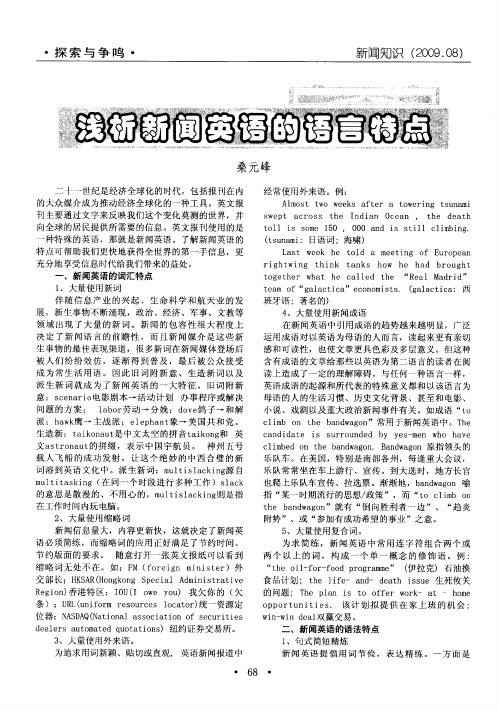
t a f “ a a t c ”e o o i t . (a a t c : 西 e m o g l c ia c n m s S g l c ia
班 牙 语 :著名 的)
4 、大 量 使 用 新 闻成 语 在 新 闻 英语 中 引 用成 语 的 趋 势 越 来 越 明 显 , 广泛 运 用 成 语 对 以英 语 为 母 语 的人 而 言 ,读 起 来 更有 亲切 感 和 可 读 性 ,也 使 文 章 更 具 色 彩 及 多层 意义 。但 这 种 含 有 成 语 的 文 章 给 那 些 以英 语 为第 二语 言 的读 者 在 阅 读 上 造 成 了一 定 的理 解 障 碍 。 与任 何 一 种 语 言 一样 , 英 语 成 语 的 起 源 和 所 代 表 的特 殊 意 义 都 和 以 该语 言 为 母 语 的 人 的 生 活 习惯 、历 史 文 化 背 景 、甚 至 和 电 影 、 小 说 、 戏 剧 以及 重 大 政 治 新 闻事 件 有 关 。如 成 语 “ o t
一
经 常 使 用 外来 语 。例 :
Al mos t wee aft r t we ng t un mi t wo ks e a o ri s a s pt acrosS t I we he ndi Ocean , the de an ath
t l i s m 1 0 , 0 0 n i s i l l m i g o 1 S oe 5 0 a d S t l c i b n .
(s nm : 口语词 :海 啸 ) tua i
Las we he t d a t ek ol meeti o E ng f uro an pe
r g t n t n t n h w e i h wi g hi k a ks o h ha b o g t d r u h t g t e w a h c l e t e “ e l a ri ” o e h r h t e a l d h R a M d d
- 1、下载文档前请自行甄别文档内容的完整性,平台不提供额外的编辑、内容补充、找答案等附加服务。
- 2、"仅部分预览"的文档,不可在线预览部分如存在完整性等问题,可反馈申请退款(可完整预览的文档不适用该条件!)。
- 3、如文档侵犯您的权益,请联系客服反馈,我们会尽快为您处理(人工客服工作时间:9:00-18:30)。
• 2.复合形容词:war-weary(厌倦战争的), topheavy(头重脚轻的), bitter-sweet(又苦又甜的; 又苦又乐的), freezing cold(冰冷的) • 3.复合动词: wallet X-ray(钱袋透视,指收治 病人前对其经济支付能力的审查), handcarry(手提), vacuum clean(真空吸尘), mass produce(批量生产), tape-record(用磁 带为„录音)
8.网络新词
• 科技的迅猛发展和因特网的出现为语言带来大 量新的词汇。在众多的心词汇当中,首字母缩 略词(Acronyms)所占的比例较大。常用的 有: • BBS:bulletin board system公告牌系统 • DN:domain name域名 • FAQ:frequently asked question常见问题 • FTP:file transfer protocol文件传送协议 • HTML: hyper text makeup language超文本 标记语言
• 其他形式: • 1.借助说意动词。例如:State Department Spokesman John Hughes issued a polite and justified scolding:”The tradition has been not to criticize the U.S. from foreign platforms– particularly from countries hostile to the U.S.”. • 2. 借助表示说话态度的形容词。例如:Post Executive Editor Ben Bradles was more upbeat:”We are delighted our reporting was vindicated(证明…正确). It is great day for newspaper. ”
• 与词义升格相反的语言现象是词义降格。词义 降格指词从原先表示中性意义或者褒义转为表 示贬义,如:peasant(农民→粗野无知的 人), vulgar(普通人的→庸俗的), propaganda(宣传→宣传伎俩), gay(高兴的 →男同性恋的), hussy(家庭妇女→轻佻的 女人), villain(村民→坏人)。
• 倒金字塔模式具有以下三大优点:方便听者和 读者(可以从导语中获得主要信息),方便写 作(记者按照此模式写作十分便捷),方便编 辑重要内容),因此,新闻撰写人员比较 喜欢采用这种结构。但是也有不少新闻学者认 为它是“头重脚轻”(Top-heavy Form),浪 费篇幅,并且现在面临电子新闻媒介的挑战, 不少新的新闻写作模式已经出现。
• 由web-构成的词:webcasting 网络播放, webpage 网页, web TV, webzine 网络杂志, webmaster 网站管理员, website • 由net-构成的词:netwriter 发送电子函件的人, netfiles 网络文件, netgroup 网络用户组, nethead 网虫, net-surf 网上冲浪
新闻英语语言特征
新闻英语五大特色
• 大众性:要适合广大听众的水平,语言必须通 俗易懂 • 节俭性:力求在短的时间内尽可能提供多的信 息,语言要简洁 • 趣味性:生动有趣,才能吸引听众注意力 • 时新性:新闻的价值 • 客观性:新闻报道应遵循的准则,文字应准确 具体
1.句式精炼
新闻报道中常常使用省略手段来精炼句式。较为 常见的省略现象有: 1.省去冗词赘语,下划线部分均为多余,通常略 去。 如gather together; at the present time; cancel out; necessary requirement; copperate together;small in size; true facts 2.省去可以略去的冠词。 Single mum Mechell Brinham is at (the) center of public opinions .
• • • • •
3. 联系动词 例1:Cops under Fire(Cops Are under Fire) 例2:Bankers Silent (Bankers Keep Silent ) 4.被动语态或进行时的助动词 例1:Pensioner raped, Criminal jailed(A pensioner was raped, the criminal is jailed) • 例2:Bulls closing in on sixth title(Bulls is closing in on sixth title)
• 3. 借助介词短语“according to”。例如: But according to a top White House official,”Until Jim Baker and his legislative group took the thing over, we didn’t have a very good idea of whether or how we could win.”
3.引语的使用
• 引语的使用使语言“具有强烈的真实感和直接 感,同时可以增加结构的变化和趣味性”。三 种基本形式: • (1).“说”意动词连接直接引语:“The world signs of hope,”James said. • (2) 间接引语:He added that China supported the WTO’s plan„ • (3) 间接引语中混用直接引语:„Shi Guangsheng said his country will “abide (遵守 )by WTO rules and honor its commitments while enjoying his rights.”
2.倒金字塔结构
• 典型的纯新闻报道,篇章结构采用的是比较常 见的“倒金字塔模式”( Inverted Pyramid Form )。这种模式是按新闻事实重要性梯降 式进行布局。最重要的新闻事实安排在文章的 开头(也称新闻导语),较为次要的内容紧接 导语之后,一般是导语中的新闻要素的说明和 扩展,最为次要的内容放在末尾。这样所组合 的文章便形成顶部大,底部小的倒三角形状, 西方新闻学称此为“倒金字塔结构” (Inverted Pyramid Form)。
• 3. 省去宾语从句连接词。 • Pepsi announced (that) it would use Sunett sweetner in a new drink. • 4.省去大城市后的州名。 • An army of bikers wearing black leatherand-denim(皮革-牛仔装) rumbled(发出隆隆声) through the streets of Milwaukee ( Wisconsin), (on) Saturday. • 5. 使用省略句。 • He said (that) he intended to keep fighting if (he is)elected.
6.复合词
• 复合法是把两个或两个以上的词结合在一起构 成新词的方法。复合法可以起到使语句精炼生 动的作用。 • 复合词按词性分类有复合名词,复合形容词, 复合动词,复合介词,复合副词,复合代词, 复合数词,但数量较多的是前三种。 • 1.复合名词:hot line(热线), soft line(温和路 线), identity crisis(性格认同危机), cruise missile(巡航导弹), website(网址), checkbook participation(支票参战;出钱不 出兵的参战), human shield(人肉盾牌)
4.词义的升降
• 词义的升格指词从原先表示中性意义或贬义转 为表示褒义,如:nimble(偷东西手脚敏捷的 →巧的,敏捷的),shrewd(邪恶的→机灵 的), craftsman(骗术高明的人→名匠), paradise(花园→天堂), cool(凉爽感的→时 髦的,酷), crazy(疯狂的→极好的), natural(天然的→无污染的,有益健康的), green(绿色的→有益环境保护的).
• 例如: • SEOUL---Japanese Prime Minister Junichiro Koizumi’s visit to the Yasukuni war shrine (神殿) on Monday sparked anger and outrage throughtout Asia. • Who: Japanese Prime Minister Junichiro Koizumi • What: (His)visit to the Yasukuni war shrine sparked anger and outrage • When: on Monday • where: throughtout Asia.
• 标题除采用省略手段精炼句式外,还使用名词 定语,省去前置词: • 例1:Bread Price Rise(A Rise in the Price of Bread) • 例2:Nuke Protesters Convicted (Protesters against Nuclear Weapons Are Convicted )
常见的说意动词
• Acknowledge,add,admit, affirm, allege (断言), agree, announce, argue, ask, assert, boast, claim, complain, challenge (提出异议), conclude, contend(争论), declare, elaborate(详述), emphasize, explain, imply, enquire, insist, joke, maintain(断言), object, observe(评述), promise, pledge, reply, refute(反驳), retort(反诘), reveal, state, stress, suggest
